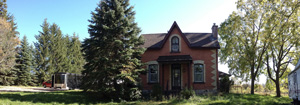She may have left when she was 18, but Nobel laureate Alice Munro's native Huron County – she grew up on a farm outside of Wingham – influenced her life's work, both in setting and sensibility. Photographer Deborah Baic visited the Southwestern Ontario community behind her exceptional writing about the lives of ordinary girls and women.

Thanksgiving traditions
By the time Maury brought her down to the lake on Sunday morning, the turkey was already in the oven. The pies were on the kitchen counter—pumpkin, apple, wild blueberry. Gretchen was in charge of the kitchen, as coördinated a cook as she was an athlete. Mrs. Travers sat at the kitchen table, drinking coffee and working on a jigsaw puzzle with Gretchen’s younger daughter, Dana.
“Ah, Grace,” she said, jumping up for an embrace—the first time she had ever done this—and with a clumsy motion of her hand scattering the jigsaw pieces.
Dana wailed, “Grand-ma,” and her older sister, Janey, who had been watching critically, scooped up the pieces.
“We can easy put them back together,” she said. “Grandma didn’t mean to.”
“Where do you keep the cranberry sauce?” Gretchen asked.
“In the cupboard,” Mrs. Travers said, still squeezing Grace’s arms and ignoring the destroyed puzzle.
“Where in the cupboard?”
“Oh. Cranberry sauce,” Mrs. Travers said. “Well, I make it. First I put the cranberries in a little water. Then I keep it on low heat—no, I think I soak them first—”
“Well, I haven’t got time for all that,” Gretchen said. “You mean you don’t have any canned?”
“I guess not. I must not have, because I make it.”
“I’ll have to send somebody to get some.”
“Dear, it’s Thanksgiving,” Mrs. Travers said gently. “Nowhere will be open.”
From Passion

A farm’s rolling fields just on the edge of town
We lived at the end of a road running west from Dalgleish over some scrubby land where there were small wooden houses and flocks of chickens and children. The land rose to a decent height where we were and then sloped in wide fields and pastures, decorated with elm trees, down to the curve of the river. Our house was decent too, an old brick house of a fair size, but it was drafty and laid out in an inconvenient way and the trim needed paint. My mother planned to fix it up and change it all around, as soon as we got some money.”
From Chaddeleys and Flemings

The local theatre in the centre of town
I lived when I was young at the end of a long road, or a road that seemed long to me. Back behind me, as I walked home from primary school, was the real town with its activity and its sidewalks and its streetlights for after dark. Marking the end of town were two bridges over the Maitland River: one narrow iron bridge, where cars sometimes go into trouble over which one should pull off and wait for the other, and a wooden walkway which occasionally had a plank missing, so that you could look right down into the bright, burying water. I liked that, but somebody always came and replaced the plank eventually.
From Dear Life

A river runs through it
The east side of our house and the west side looked on two different worlds, or so it seemed to me. The east side was the town side, even though you could not see any town. Not so much as two miles away, there were houses in rows, with streetlights and running water. And though I have said you could not see any of that, I am really not sure that you couldn’t get a certain glow if you stared long enough.
To the west, the long curve of the river and the fields and the trees and the sunsets had nothing to interrupt them. Nothing to do with people, in my mind, or to do with ordinary life, ever.
From Night